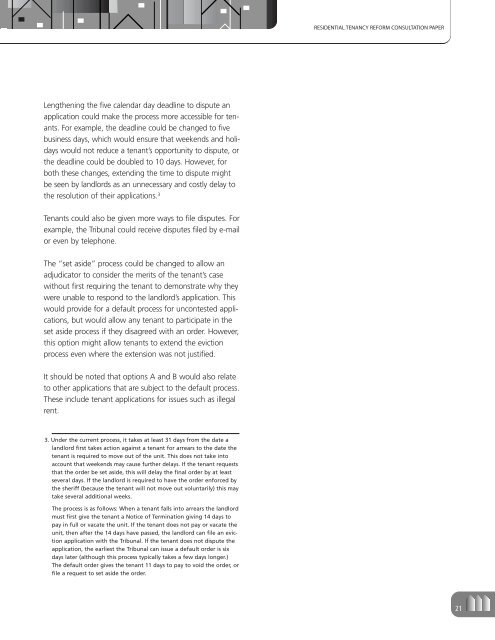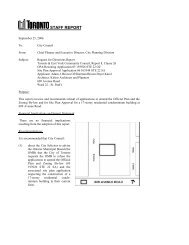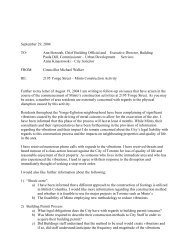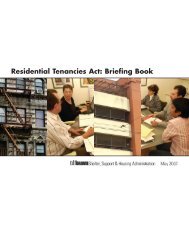Residential Tenancy Reform Consultation Paper
Residential Tenancy Reform Consultation Paper - Michael Walker
Residential Tenancy Reform Consultation Paper - Michael Walker
You also want an ePaper? Increase the reach of your titles
YUMPU automatically turns print PDFs into web optimized ePapers that Google loves.
RESIDENTIAL TENANCY REFORM CONSULTATION PAPER<br />
Lengthening the five calendar day deadline to dispute an<br />
application could make the process more accessible for tenants.<br />
For example, the deadline could be changed to five<br />
business days, which would ensure that weekends and holidays<br />
would not reduce a tenant’s opportunity to dispute, or<br />
the deadline could be doubled to 10 days. However, for<br />
both these changes, extending the time to dispute might<br />
be seen by landlords as an unnecessary and costly delay to<br />
the resolution of their applications. 3<br />
Tenants could also be given more ways to file disputes. For<br />
example, the Tribunal could receive disputes filed by e-mail<br />
or even by telephone.<br />
The “set aside” process could be changed to allow an<br />
adjudicator to consider the merits of the tenant’s case<br />
without first requiring the tenant to demonstrate why they<br />
were unable to respond to the landlord’s application. This<br />
would provide for a default process for uncontested applications,<br />
but would allow any tenant to participate in the<br />
set aside process if they disagreed with an order. However,<br />
this option might allow tenants to extend the eviction<br />
process even where the extension was not justified.<br />
It should be noted that options A and B would also relate<br />
to other applications that are subject to the default process.<br />
These include tenant applications for issues such as illegal<br />
rent.<br />
3. Under the current process, it takes at least 31 days from the date a<br />
landlord first takes action against a tenant for arrears to the date the<br />
tenant is required to move out of the unit. This does not take into<br />
account that weekends may cause further delays. If the tenant requests<br />
that the order be set aside, this will delay the final order by at least<br />
several days. If the landlord is required to have the order enforced by<br />
the sheriff (because the tenant will not move out voluntarily) this may<br />
take several additional weeks.<br />
The process is as follows: When a tenant falls into arrears the landlord<br />
must first give the tenant a Notice of Termination giving 14 days to<br />
pay in full or vacate the unit. If the tenant does not pay or vacate the<br />
unit, then after the 14 days have passed, the landlord can file an eviction<br />
application with the Tribunal. If the tenant does not dispute the<br />
application, the earliest the Tribunal can issue a default order is six<br />
days later (although this process typically takes a few days longer.)<br />
The default order gives the tenant 11 days to pay to void the order, or<br />
file a request to set aside the order.<br />
21






